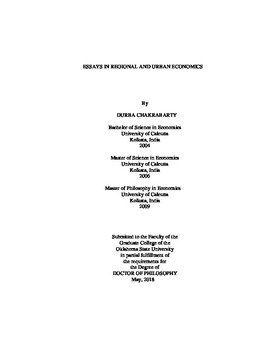| dc.contributor.advisor | Rickman, Dan S. | |
| dc.contributor.author | Chakrabarty, Durba | |
| dc.date.accessioned | 2019-03-25T21:13:45Z | |
| dc.date.available | 2019-03-25T21:13:45Z | |
| dc.date.issued | 2018-05 | |
| dc.identifier.uri | https://hdl.handle.net/11244/317735 | |
| dc.description.abstract | My dissertation contains three applied essays. The first essay examines how proximity to higher-tiered centers in the urban hierarchy affects the population growth. The massive population growth in India is not driven by amenities. I find a negative and statistically significant effect of the nearest city distance variable on the growth rates of towns. In terms of distance penalty for towns, it is approximately 6.1% less population growth given the mean distance to its nearest city averaged at 53.57 km. Thus, my findings lend support to the hypothesis of urban hierarchical effects as evident in other countries like United States, Canada and China. | |
| dc.description.abstract | The second essay document assimilation patterns of broad race and Asian immigrants groups on attaining a STEM major by different ages of arrival. Among the child immigrants, the early arrivals (0-5 years) are less likely to specialize in STEM major compared to the late arrivals for white and Asians. The assimilation pattern in terms of attainment of STEM majors for the immigrant groups depends on the length of stay in the destination country. The later age of arrival groups (12-17 years) have already acquired a larger part of K-12 education in STEM driven countries of Asia like India and China and developed their math and science skills. | |
| dc.description.abstract | The third essay examine the spread and backwash effects of urban growth on the hinterlands of India. The dynamics of rural areas are unique in the context of India and needs to be addressed separately. The uniqueness stems from the definition of rural areas by the Census of India. A negative and statistically significant effect of the nearest town distance and incremental distance to a city variable on the growth rates of villages is found in this study. Thus, the villages experience spread effects for being in close proximity to a town and a city but backwash effects for being closer to a large city. The distance penalty or protection varies by the position of tier in the urban hierarchy. | |
| dc.format | application/pdf | |
| dc.language | en_US | |
| dc.rights | Copyright is held by the author who has granted the Oklahoma State University Library the non-exclusive right to share this material in its institutional repository. Contact Digital Library Services at lib-dls@okstate.edu or 405-744-9161 for the permission policy on the use, reproduction or distribution of this material. | |
| dc.title | Essays in regional and urban economics | |
| dc.contributor.committeeMember | Winters, John V. | |
| dc.contributor.committeeMember | Azam, Mehtabul | |
| dc.contributor.committeeMember | Shideler, Dave | |
| osu.filename | Chakrabarty_okstate_0664D_15666.pdf | |
| osu.accesstype | Open Access | |
| dc.type.genre | Dissertation | |
| dc.type.material | Text | |
| thesis.degree.discipline | Economics | |
| thesis.degree.grantor | Oklahoma State University | |
